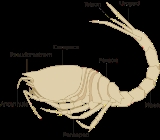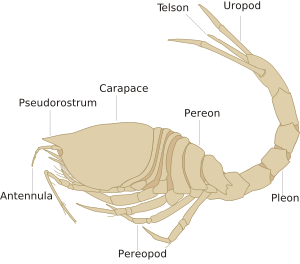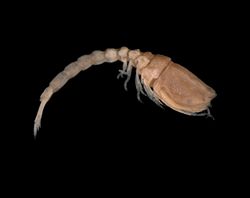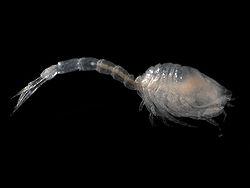
Cumacea
Encyclopedia
Cumacea is an order
of small marine crustacean
s, occasionally called hooded shrimp. Their unique appearance and uniform body plan
makes them easy to distinguish from other crustaceans.
 Cumaceans have a strongly enlarged carapace
Cumaceans have a strongly enlarged carapace
(head shield) and pereon (breast shield), a slim abdomen
and a forked tail. The length of most species varies from 1 to 10 mm (0.0393700787401575 to 0.393700787401575 ).
The carapace of a typical cumacean is composed of several fused dorsal head parts and the first three somite
s of the thorax
. This carapace encloses the appendages that serve for respiration
and feeding. In most species, there are two eyes at the front side of the head shield, often merged into a single eye lobe. The five posterior somites of the thorax form the pereon. The pleon
(abdomen) consists of six cylindrical somites.
The first antenna (antennule) has two flagella
, the outer flagellum usually being longer than the inner one. The second antenna
is strongly reduced in females, and consists of numerous segments in males.
Cumaceans have six pairs of mouthparts: one pair of mandibles
, one pair of maxillules, one pair of maxillae
and three pairs of maxillipeds.
 Cumaceans are mainly marine crustaceans. However, some species can survive in water with a lower salinity
Cumaceans are mainly marine crustaceans. However, some species can survive in water with a lower salinity
, like brackish water
(e.g. estuaries
). In the Caspian Sea
they even reach some rivers that flow into it. Few species live in the intertidal zone
.
Most species live only one year or less, and reproduce twice in their lifetime. Deepsea species have a slower metabolism
and presumably live much longer.
Cumaceans feed mainly on microorganism
s and organic material from the sediment
. Species that live in the mud filter their food, while species that live in sand browse individual grains of sand. In the genus Campylaspis and a few related genera, the mandibles are transformed into piercing organs, which can be used for predation
on foram
s and small crustaceans.
Many shallow water species show a diurnal
cycle, with males emerging from the sediment at night and swarming to the surface.
, cumaceans are an important food source for many fishes. Therefore, they are an important part of the marine food chain
. They can be found on all continents.
 Cumaceans are a clear example of sexual dimorphism
Cumaceans are a clear example of sexual dimorphism
: males and females differ significantly in their appearance. Both sexes have different ornaments (setation, knobs, and ridges) on their carapace. Other differences are the length of the second antenna, the existence of pleopods in males, and the development of a marsupium
in females. There are generally more females than males, and females are also larger than their male counterparts.
Cumaceans are epimorphic, which means that the number of body segments doesn't change during the different developmental stages. This is a form of incomplete metamorphosis. Females carry the embryos in their marsupium for some time. The larvae leave the marsupium during the so-called manca stage, in which they are almost fully grown and only miss their last pair of pereopods.
. In 1846, they were recognized as a separate order by Henrik Nikolaj Krøyer
. Twenty-five years later about fifty different species had been described, and currently there are more than 1,400 described species. The German zoologist Carl Wilhelm Erich Zimmer
studied the order Cumacea very intensively.
, within the class Malacostraca
. The order Cumacea is subdivided into 8 to 11 families, about 139 genera, and 1593 species. The families most marine zoologists recognize are:
Order (biology)
In scientific classification used in biology, the order is# a taxonomic rank used in the classification of organisms. Other well-known ranks are life, domain, kingdom, phylum, class, family, genus, and species, with order fitting in between class and family...
of small marine crustacean
Crustacean
Crustaceans form a very large group of arthropods, usually treated as a subphylum, which includes such familiar animals as crabs, lobsters, crayfish, shrimp, krill and barnacles. The 50,000 described species range in size from Stygotantulus stocki at , to the Japanese spider crab with a leg span...
s, occasionally called hooded shrimp. Their unique appearance and uniform body plan
Body plan
A body plan is the blueprint for the way the body of an organism is laid out. An organism's symmetry, its number of body segments and number of limbs are all aspects of its body plan...
makes them easy to distinguish from other crustaceans.
Anatomy

Carapace
A carapace is a dorsal section of the exoskeleton or shell in a number of animal groups, including arthropods such as crustaceans and arachnids, as well as vertebrates such as turtles and tortoises. In turtles and tortoises, the underside is called the plastron.-Crustaceans:In crustaceans, the...
(head shield) and pereon (breast shield), a slim abdomen
Abdomen
In vertebrates such as mammals the abdomen constitutes the part of the body between the thorax and pelvis. The region enclosed by the abdomen is termed the abdominal cavity...
and a forked tail. The length of most species varies from 1 to 10 mm (0.0393700787401575 to 0.393700787401575 ).
The carapace of a typical cumacean is composed of several fused dorsal head parts and the first three somite
Somite
A somite is a division of the body of an animal. In vertebrates this is mainly discernible in the embryo stage; in arthropods it is a characteristic of a hypothetical ancestor.- In vertebrates :...
s of the thorax
Thorax
The thorax is a division of an animal's body that lies between the head and the abdomen.-In tetrapods:...
. This carapace encloses the appendages that serve for respiration
Respiratory system
The respiratory system is the anatomical system of an organism that introduces respiratory gases to the interior and performs gas exchange. In humans and other mammals, the anatomical features of the respiratory system include airways, lungs, and the respiratory muscles...
and feeding. In most species, there are two eyes at the front side of the head shield, often merged into a single eye lobe. The five posterior somites of the thorax form the pereon. The pleon
Pleon
Pleon is a Europe based Public Relations and communications consultancy. It is part of the Brodeur Pleon Worldwide network and a subsidiary of BBDO Worldwide. Pleon belongs to the Omnicom Group. Pleon is headquartered in Düsseldorf, Germany.- Overview :...
(abdomen) consists of six cylindrical somites.
The first antenna (antennule) has two flagella
Flagellum
A flagellum is a tail-like projection that protrudes from the cell body of certain prokaryotic and eukaryotic cells, and plays the dual role of locomotion and sense organ, being sensitive to chemicals and temperatures outside the cell. There are some notable differences between prokaryotic and...
, the outer flagellum usually being longer than the inner one. The second antenna
Antenna (biology)
Antennae in biology have historically been paired appendages used for sensing in arthropods. More recently, the term has also been applied to cilium structures present in most cell types of eukaryotes....
is strongly reduced in females, and consists of numerous segments in males.
Cumaceans have six pairs of mouthparts: one pair of mandibles
Mandible (arthropod)
thumb|250px|The mandibles of a [[Bull ant]]The mandible of an arthropod is either of a pair of mouthparts used for biting, cutting and holding food. Mandibles are often simply referred to as jaws. Mandibles are present in the extant subphyla Myriapoda , Crustacea and Hexapoda...
, one pair of maxillules, one pair of maxillae
Maxilla (arthropod)
In arthropods, the maxillae are paired structures present on the head as mouthparts in members of the clade Mandibulata, used for tasting and manipulating food. Embryologically, the maxillae are derived from the 4th and 5th segment of the head and the maxillary palps; segmented appendages extending...
and three pairs of maxillipeds.
Ecology

Salinity
Salinity is the saltiness or dissolved salt content of a body of water. It is a general term used to describe the levels of different salts such as sodium chloride, magnesium and calcium sulfates, and bicarbonates...
, like brackish water
Brackish water
Brackish water is water that has more salinity than fresh water, but not as much as seawater. It may result from mixing of seawater with fresh water, as in estuaries, or it may occur in brackish fossil aquifers. The word comes from the Middle Dutch root "brak," meaning "salty"...
(e.g. estuaries
Estuary
An estuary is a partly enclosed coastal body of water with one or more rivers or streams flowing into it, and with a free connection to the open sea....
). In the Caspian Sea
Caspian Sea
The Caspian Sea is the largest enclosed body of water on Earth by area, variously classed as the world's largest lake or a full-fledged sea. The sea has a surface area of and a volume of...
they even reach some rivers that flow into it. Few species live in the intertidal zone
Intertidal zone
The intertidal zone is the area that is above water at low tide and under water at high tide . This area can include many different types of habitats, with many types of animals like starfish, sea urchins, and some species of coral...
.
Most species live only one year or less, and reproduce twice in their lifetime. Deepsea species have a slower metabolism
Metabolism
Metabolism is the set of chemical reactions that happen in the cells of living organisms to sustain life. These processes allow organisms to grow and reproduce, maintain their structures, and respond to their environments. Metabolism is usually divided into two categories...
and presumably live much longer.
Cumaceans feed mainly on microorganism
Microorganism
A microorganism or microbe is a microscopic organism that comprises either a single cell , cell clusters, or no cell at all...
s and organic material from the sediment
Sediment
Sediment is naturally occurring material that is broken down by processes of weathering and erosion, and is subsequently transported by the action of fluids such as wind, water, or ice, and/or by the force of gravity acting on the particle itself....
. Species that live in the mud filter their food, while species that live in sand browse individual grains of sand. In the genus Campylaspis and a few related genera, the mandibles are transformed into piercing organs, which can be used for predation
Predation
In ecology, predation describes a biological interaction where a predator feeds on its prey . Predators may or may not kill their prey prior to feeding on them, but the act of predation always results in the death of its prey and the eventual absorption of the prey's tissue through consumption...
on foram
Foraminifera
The Foraminifera , or forams for short, are a large group of amoeboid protists which are among the commonest plankton species. They have reticulating pseudopods, fine strands of cytoplasm that branch and merge to form a dynamic net...
s and small crustaceans.
Many shallow water species show a diurnal
Diurnal animal
Diurnality is a plant or animal behavior characterized by activity during the day and sleeping at night.-In animals:Animals that are not diurnal might be nocturnal or crepuscular . Many animal species are diurnal, including many mammals, insects, reptiles and birds...
cycle, with males emerging from the sediment at night and swarming to the surface.
Importance
Like AmphipodaAmphipoda
Amphipoda is an order of malacostracan crustaceans with no carapace and generally with laterally compressed bodies. The name amphipoda means "different-footed", and refers to the different forms of appendages, unlike isopods, where all the legs are alike. Of the 7,000 species, 5,500 are classified...
, cumaceans are an important food source for many fishes. Therefore, they are an important part of the marine food chain
Food chain
A food web depicts feeding connections in an ecological community. Ecologists can broadly lump all life forms into one of two categories called trophic levels: 1) the autotrophs, and 2) the heterotrophs...
. They can be found on all continents.
Reproduction and development

Sexual dimorphism
Sexual dimorphism is a phenotypic difference between males and females of the same species. Examples of such differences include differences in morphology, ornamentation, and behavior.-Examples:-Ornamentation / coloration:...
: males and females differ significantly in their appearance. Both sexes have different ornaments (setation, knobs, and ridges) on their carapace. Other differences are the length of the second antenna, the existence of pleopods in males, and the development of a marsupium
Brood pouch (Peracarida)
The marsupium or brood pouch, is a characteristic feature of Peracarida, including the orders Amphipoda, Isopoda and Cumacea. It is an egg chamber formed by oostegites, which are appendices which are attached to the coxae of the first pereiopods...
in females. There are generally more females than males, and females are also larger than their male counterparts.
Cumaceans are epimorphic, which means that the number of body segments doesn't change during the different developmental stages. This is a form of incomplete metamorphosis. Females carry the embryos in their marsupium for some time. The larvae leave the marsupium during the so-called manca stage, in which they are almost fully grown and only miss their last pair of pereopods.
History of research
The order of Cumacea was already known since 1780, when Ivan Ivanovich Lepekhin described the species Oniscus scorpioides (later renamed to Diastylis scorpioides). During that time, many scientists thought that the cumaceans were some kind of larval stage of decapodsDecapoda
The decapods or Decapoda are an order of crustaceans within the class Malacostraca, including many familiar groups, such as crayfish, crabs, lobsters, prawns and shrimp. Most decapods are scavengers. It is estimated that the order contains nearly 15,000 species in around 2,700 genera, with...
. In 1846, they were recognized as a separate order by Henrik Nikolaj Krøyer
Henrik Nikolaj Krøyer
Henrik Nikolai Krøyer was a Danish zoologist.Born in Copenhagen, he was a brother of the composer Hans Ernst Krøyer. He started studying medicine at the University of Copenhagen in 1817, which he later changed to history and philology...
. Twenty-five years later about fifty different species had been described, and currently there are more than 1,400 described species. The German zoologist Carl Wilhelm Erich Zimmer
Carl Wilhelm Erich Zimmer
Carl Wilhelm Erich Zimmer was a German zoologist specialising in crustaceans, especially the order Cumacea. He worked in Berlin, and is the taxonomic authority for the krill species Euphausia hanseni.-References:*....
studied the order Cumacea very intensively.
Fossil record
The fossil record of cumaceans is very sparse, but extends back into the Mississippian age.Taxonomy
Cumaceans belong to the superorder PeracaridaPeracarida
The superorder Peracarida is a large group of malacostracan crustaceans, having members in marine, freshwater, and terrestrial habitats. They are chiefly defined by the presence of a brood pouch, or marsupium, formed from thin flattened plates borne on the basalmost segments of the legs Other...
, within the class Malacostraca
Malacostraca
Malacostraca is the largest of the six classes of crustaceans, containing over 25,000 extant species, divided among 16 orders. Its members display a greater diversity of body forms than any other class of animals, and include crabs, lobsters, shrimp, krill, woodlice, scuds , mantis shrimp and many...
. The order Cumacea is subdivided into 8 to 11 families, about 139 genera, and 1593 species. The families most marine zoologists recognize are:
- BodotriidaeBodotriidaeBodotriidae is a family of crustaceans belonging to the order Cumacea.-Anatomy:In both sexes the telson is fused with the last segment of the pleon, forming a "pleotelson". Males generally have five pairs of pleopods, although less often there may be three, two or they may be entirely absent. In...
Scott, 1901 (360 species) - CeratocumatidaeCeratocumatidaeCeratocumatidae is a family of crustaceans of the order Cumacea. Ceratocumatidae have a small free telson. The endopods of the uropods are present on only one segment. Males have 5, 4 or 3 pairs of pleopods. All maxillipeds and some of the pereiopods bear exopods . The gill apparatus has no...
CalmanWilliam Thomas CalmanWilliam Thomas Calman was a Scottish zoologist, specialising in the Crustacea.He was born in Dundee, studying at the High School. In the scientific societies in the city, he met D'Arcy Thompson. He later became Thompson's lab boy, which allowed him to attend lectures at University College, Dundee...
, 1905 (8 species) - DiastylidaeDiastylidaeDiastylidae is one of the eight most commonly recognised families of crustaceans of the order Cumacea. They are marine creatures especially common around the 30th parallel north.-Anatomy:...
BateCharles Spence BateCharles Spence Bate, or Spence Bate, FRS was a British zoologist and dentist, who who practiced first at Swansea, and then Plymouth, taking over his father's practice. He was an authority on the Crustacea, and a frequent correspondent of Charles Darwin, mostly concerning their shared interest in...
, 1856 (281 species) - GynodiastylidaeGynodiastylidaeGynodiastylidae is one the eight most commonly recognised families of crustaceans of the order Cumacea. They are especially prevalent in the southern hemisphere, with some types described from Japan, Thailand and the Persian Gulf. Most are found at less than depth.-Anatomy:Gynodiastylidae have a...
StebbingThomas Roscoe Rede StebbingThe Reverend Thomas Roscoe Rede Stebbing F.R.S., F.L.S. was a British zoologist, who described himself as "a serf to natural history, principally employed about Crustacea". Educated in London and Oxford, he only took to natural history in his thirties, having worked as a teacher until then...
, 1912 (103 species) - LampropidaeLampropidaeLampropidae is a family of cold-water crustaceans belonging to the order Cumacea. Members of Lampropidae are relatively easily recognised because they all at have at least three terminal setae on the telson . The telson is medium to large and not fused with the last segment of the pleon...
SarsGeorg SarsGeorg Ossian Sars was a Norwegian marine biologist.Georg Ossian Sars was born on April 20, 1837, in Kinn, Norway , the son of Michael Sars and Maren Sars; the historian Ernst Sars was his elder brother, and the singer Eva Nansen was his younger sister. He grew up in Manger, Hordaland, where his...
, 1878 (90 species) - LeuconidaeLeuconidaeLeuconidae is a family of marine hooded shrimp . These malacostracan crustaceans belong to the superorder Peracarida, unlike true shrimp, which are Eucarida. The family was established by Georg Ossian Sars in his 1878 study of Mediterranean cumaceans.- Description :Leuconidae retain the original...
Sars, 1878 (121 species) - NannastacidaeNannastacidaeNannastacidae is a family of crustaceans belonging to the order Cumacea.- Anatomy :Nannastacidae have no free telson. The endopods of the uropods are present on one segment. There are exopods on the maxillipeds and generally one on pereopods 1–4 in males and 1–2 in females. Males possess five...
Bate, 1866 (350 species) - PseudocumatidaePseudocumatidaePseudocumatidae are a family of crustaceans of the order Cumacea.- Anatomy :Pseudocumatidae have a small, free telson. The uropods bear endopods on one segment. The males have two pairs of rather rudimentary pleopods and the flagella of the second antenna reach far beyond the pereon. In females...
Sars, 1878 (29 species)

